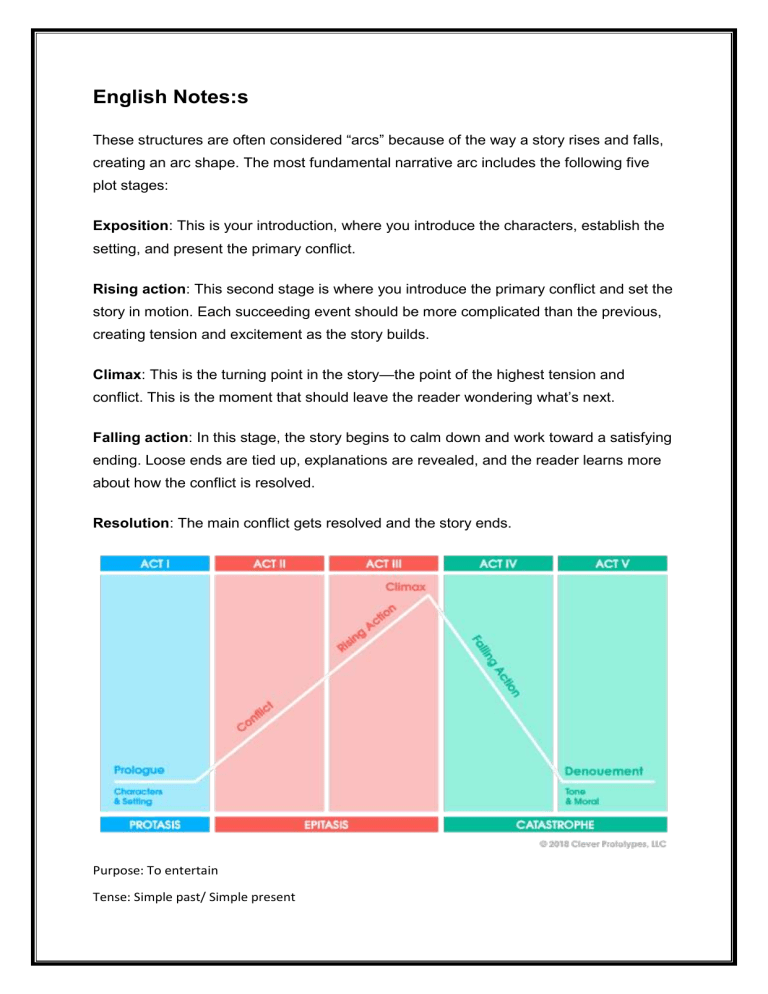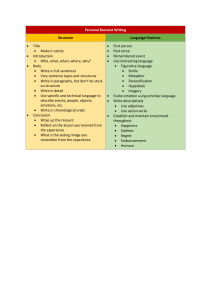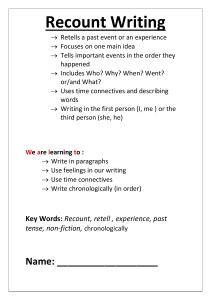
English Notes:s These structures are often considered “arcs” because of the way a story rises and falls, creating an arc shape. The most fundamental narrative arc includes the following five plot stages: Exposition: This is your introduction, where you introduce the characters, establish the setting, and present the primary conflict. Rising action: This second stage is where you introduce the primary conflict and set the story in motion. Each succeeding event should be more complicated than the previous, creating tension and excitement as the story builds. Climax: This is the turning point in the story—the point of the highest tension and conflict. This is the moment that should leave the reader wondering what’s next. Falling action: In this stage, the story begins to calm down and work toward a satisfying ending. Loose ends are tied up, explanations are revealed, and the reader learns more about how the conflict is resolved. Resolution: The main conflict gets resolved and the story ends. Purpose: To entertain Tense: Simple past/ Simple present What is a Descriptive Essay? The definition of a descriptive essay is a type of composition or paper which describes an object, person, process, or event. The writer’s goal is to create a vivid reading experience, or to show instead of tell (metaphorically). Descriptive writing usually appeals to the five senses: taste, touch, smell, hearing, and sight. (Ex: Jack’s coffee mug exploded into tiny shards of glass, catching the attention of everyone at the office.) Always appealing to the senses is key to writing a good descriptive essay. When writing a descriptive essay, your goal will be to paint a comprehensive picture for the reader by appealing to the five senses. Last but not least, your work should have a purpose. It could be anything from a lesson you learned from an experience, to a story of how an object impacted your life. It’s all about making your bright ideas come to life. The Issues that Could be Described in Your Paper A person. In this paper, you can talk about a person. It can range from simply writing about their appearance to more complex descriptions like actions, behaviours, mood, and qualities of your chosen individual. A place. The main thing you should do when describing a place in your work is to describe it interestingly and originally. Your reader(s) should feel, for example, the beauty of your chosen cities—perhaps New York or Rome. An event. Here you need to describe the story of what happened. It can be your last vacation, concert, wedding, anniversary, summer music festival, graduation day, or so on. An animal. In this type, you need to describe the animal. It may be its appearance, behaviour, or biology. An occupation. Here you need to write about a job or occupation. A behaviour. This is the type of descriptive writing you should go for if you would like to write about someone’s behaviour. Perhaps you want to describe the strange behaviour of your friend, or highlight how certain people act under different conditions. Creating a Descriptive Essay Outline When thinking about descriptive essay writing, remember that a structured paper outline is your golden ticket. Not only does it help you organize thoughts, but it will also help your essays flow better. A descriptive essay outline is composed of the following: An introduction Hook sentence Context/Background information Thesis statement Body paragraphs Topic sentence Sensory details Actual details A conclusion Summary of all main points Structure of Persuasive Article Introduction • Hook – interesting first sentence • Background information – give context to your argument/subject; familiarize the reader with the content • Definitions – define any terms that the reader might find usual/unfamiliar • Thesis – a clear, concise statement of your main argument; the overall idea you’ll be arguing. Your thesis will also serve as a roadmap for the rest of your essay, giving the reader a general idea of the path your argument will follow. Each Body Paragraph × 3 • Only one point to support your thesis per paragraph • Topic sentence • reflects the main idea of the paragraph • links back to support the thesis • Evidence – information from a reliable outside source (not your own opinion) that supports the main idea of the paragraph • Analysis – show how your evidence supports your argument; build your argument Conclusion • Tie up the essay – briefly sum up the main point • Establish significance (see “So What?” handout) • Bonus: give the reader food for thought Formal Letter Writing Topics There could be many reasons to write a formal letter meaning. They are: Sick Leave Application Leave Application for Marriage Leave application for maternity Resignation letter Appointment letter Job offer letter Complaint letter Business letter : How to Write a Formal Letter? Here are the key elements of the formal letter and what to include in each section: Sender’s Address In Formal Letter Format, it is important that you mention the sender’s address in order to avoid any confusion and dispute. Date Mention the accurate date for better understanding of the actual time and date. Name / Designation of Addressee Skipping this part can lead to potential confusion thus it is necessary to include the proper name as well as the designation of the receiver. Address of the Addressee Mentioning the accurate address of the letter will ensure that it reaches the proper destination. Salutation This part is of utmost importance as you need to address the receiver with proper respect. Subject Write a strong subject line which can convey the meaning of the entire formal letter. Body [Introduction, Content, Conclusion] It is important that you write your message in the body with precision and in a concise manner. Complimentary Closing Line Write some complimentary closing line at the end of the body. It will include words like With Regards, Best Wishes, Yours truly etc. Signature / Name of the Sender Don’t forget to include the name of the person who is sending the letter. It will clear ambiguity in the message. Designation of the Sender For the final element of the letter, you must include a proper designation of the sender. It is part and parcel of the formal letter format. These elements of a formal letter are structured as: Sender’s Address Date: XX/XX/XXXX Name / Designation of Receiver Address of the Receiver, Subject: Salutation (Mr/Mrs/ MS) Body of the Letter Signature / Name of the Sender Format of Informal Letter – How To Write an Informal Letter? The format of an informal letter to a friend should include the following things: Address of the sender Date of writing a letter Address of receiver Salutation/Greeting Body of the letter Conclusion Signature of the sender A format is shown below to write the letter in an informal manner. [Address of the Sender] Date: Dear (name of person) Body of the letter: Paragraph 1: Ask for the well-being of the person. The main reason to write the letter Paragraph 2: Provide the details related to the subject. Paragraph 3: Conclusion and end of the letter Yours lovingly, Name of sender SAMPLE FORMAT OF DIARY ENTRY WRITING While writing the proper diary entry format, remember these five essential points which is the layout and structure of the diary. If you miss any points that’s your diary is not proper and no eligible to score full marks in any exams from the format of diary entry section. WHAT IS A RECOUNT? A recount retells an experience or an event that happened in the past. The purpose of a recount can be to inform, entertain or to reflect and evaluate. A recount can focus on a specific section of an event or retell the entire story. A recount should always be told in the order that things happened. FACTUAL / NEWSPAPER RECOUNT / HISTORICAL RECOUNT Reports the particulars of an incident by reconstructing factual information e.g. police reconstruction of an accident, historical recount, biographical and autobiographical recounts. A factual recount is an objective recount of a true event by someone not personally involved in the situation. Its purpose is either to inform, entertain or both. IMAGINATIVE RECOUNT Applies factual knowledge to an imaginary role in order to interpret and recount events e.g. A Day in the Life of a German soldier, How I manned the first mission to the moon. An imaginative recount is the re-telling of events, usually in the first person. This style of recount allows for embellishment beyond facts and events- perfect for creative writing. PROCEDURAL RECOUNT Records the steps in an investigation or experiment and thereby providing the basis for reported results or findings. A procedural recount records events such as a science experiment or cooking. Procedural recounts present the events chronologically (in the order in which happened). The purpose of procedural recounts is to inform the audience. LITERARY RECOUNT Retells a series of events for the purpose of entertainment. A literary recount is like a factual recount. Both provide details about what happened, including who was involved, when and where the event took place, and what may have resulted. A literary recount can be about real or fictional events and characters. TENSE First and third person are used most frequently and recall is always written in past tense. Present tense can be used for analysis and opinion. VOICE Both active and passive voice are used in recounts Format of formal Report Title: Name of the report Introduction: Overview of the report containing purpose of the report Main Body: Findings/ Observations Conclusion: Recommendations REVIEW WRITING A book review, like a movie review, consists of a summary and analysis. Your review should start with an introduction, then a summary of the book/movie, then your analysis and finally your conclusion. Introduction Summary Analysis Conclusion TIP….You also should try to define the books genre and make connections to another book or to yourself. • state the name of book/movie, author and date of publication • outline the thesis, main ideas of the book • thesis statement and your main ideas I really liked this book because …. I did not like this book because… This book is informative and practical because… This book is boring and unorganized because … • briefly outline the main elements of the book • should involve who, what, where, when and why This book is about… The book argues that… The setting is… The authors use… The main character… The theme… • restate your thesis • summarize your main ideas • call to action You must read this book because … Do not read this book because …. You will like this book if you like… • critically state what you like and do not like about the book • explain your ideas with specific examples from the book Action Boring Methodology Character development Suspenseful Evidence used Setting Unusual Concepts Language level Unrealistic Lay out Message of the book Exciting Vocabulary This section may be more than one paragraph. Structure of Autobiography Introduction Autobiographical statement with the main idea and crucial points of the paper Include background information to engage readers and give context Body Detailed information that supports your introduction. Include facts, reasons, and a clear and understandable transition between each paragraph. At least three paragraphs should be written. Use the autobiographical sketch to keep track of your ideas and establish a good order of appearance. Conclusion Remind your thesis statement again and summarize your paper’s ideas. Include a lesson you've learned from everything written or add your final thoughts on the piece.


